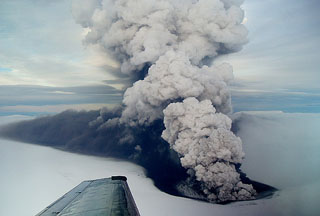Report on Grimsvotn (Iceland) — 5 October-11 October 2022
Smithsonian Institution / US Geological Survey
Weekly Volcanic Activity Report, 5 October-11 October 2022
Managing Editor: Sally Sennert.
Please cite this report as:
Global Volcanism Program, 2022. Report on Grimsvotn (Iceland) (Sennert, S, ed.). Weekly Volcanic Activity Report, 5 October-11 October 2022. Smithsonian Institution and US Geological Survey.
Grimsvotn
Iceland
64.416°N, 17.316°W; summit elev. 1719 m
All times are local (unless otherwise noted)
Icelandic Meteorological Office (IMO) reported that recent GPS measurements indicated that the ice sheet had subsided about 3 m and the lake beneath the glacier at Grímsvötn had begun to drain, though the water had not reached the glacier’s margins. IMO forecasted a small jökulhlaup and raised the Aviation Color Code to Yellow (the second lowest level on a four-color scale) on 10 October. The report noted that neither seismicity nor gas emissions were elevated, though activity at the volcano had been increasing over time. Notably, a pulse of seismic tremor was recorded for about an hour during the previous week, and magmatic gases were measured in fumarolic plumes in 2020. By 12 October the outflow of water was about 300 cubic meters per second, with the onset of the jökulhlaup occurring slower than initially calculated, and the ice sheet had subsided a total of 7 m. The flooding was likely going to be equal to that seen during the summer and would likely not impact bridges or structures.
Geological Summary. Grímsvötn, Iceland's most frequently active volcano in recent history, lies largely beneath the vast Vatnajökull icecap. The caldera lake is covered by a 200-m-thick ice shelf, and only the southern rim of the 6 x 8 km caldera is exposed. The geothermal area in the caldera causes frequent jökulhlaups (glacier outburst floods) when melting raises the water level high enough to lift its ice dam. Long NE-SW-trending fissure systems extend from the central volcano. The most prominent of these is the noted Laki (Skaftar) fissure, which extends to the SW and produced the world's largest known historical lava flow in 1783. The 15 km3 basaltic Laki lavas were erupted over 7 months from a 27-km-long fissure system. Extensive crop damage and livestock losses caused a severe famine that resulted in the loss of one-fifth of the population of Iceland.

